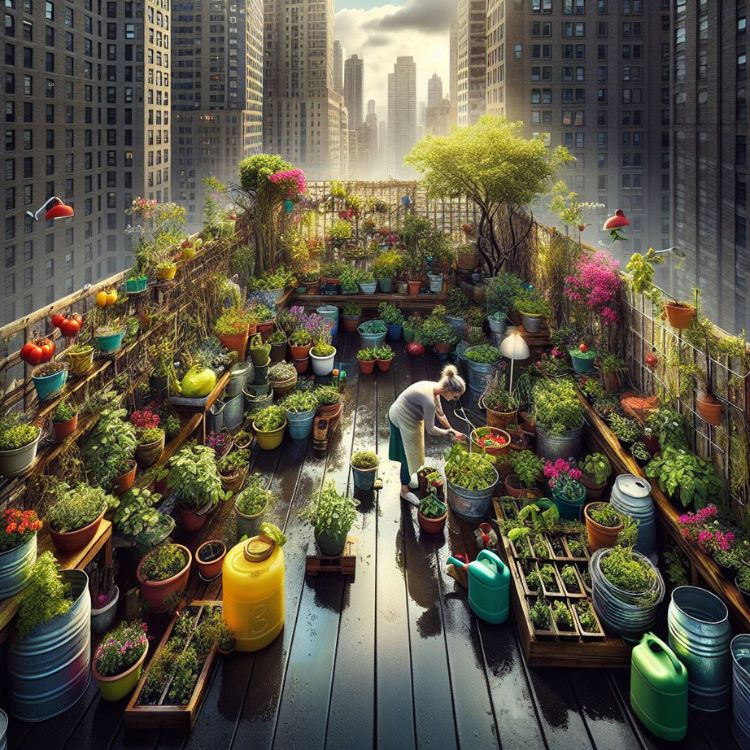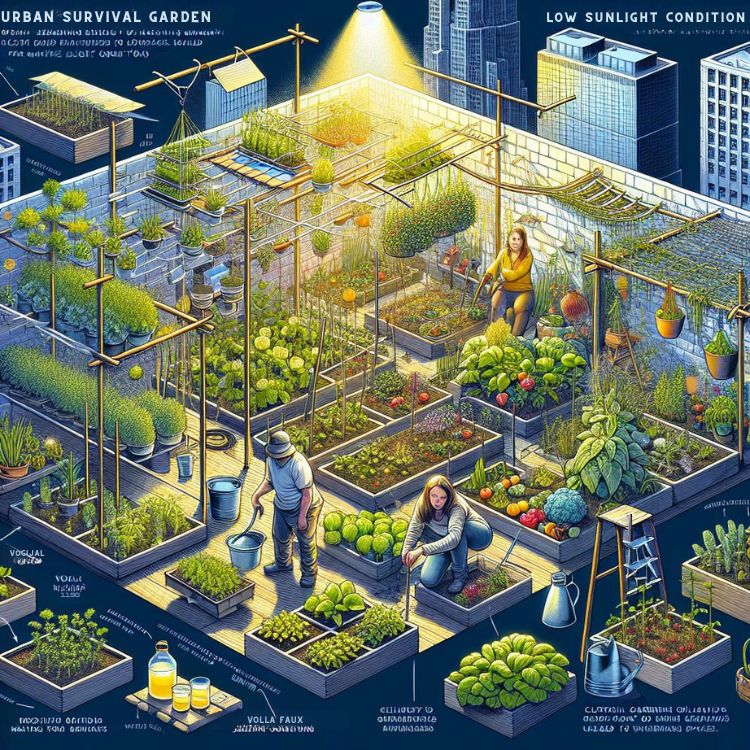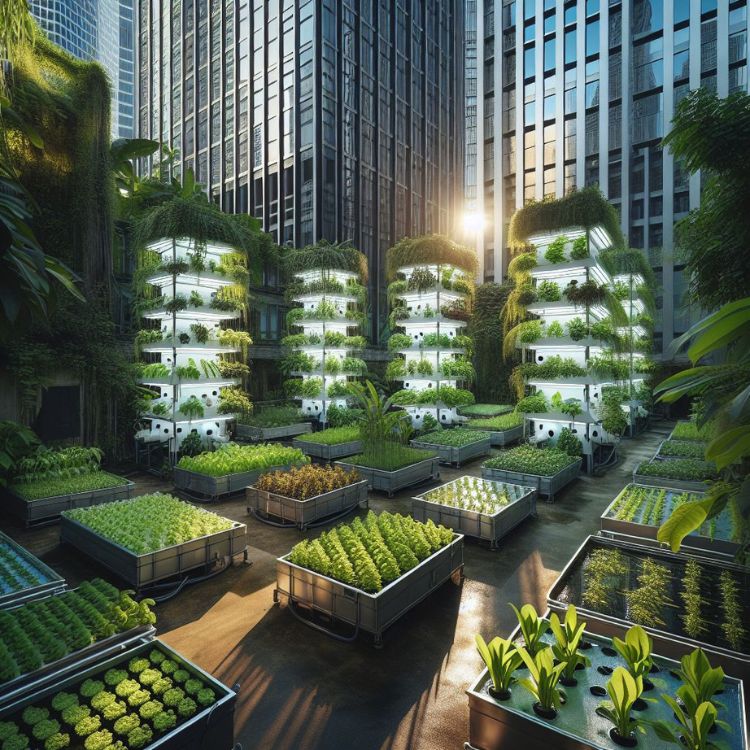
Welcome, urban gardeners! You might think limited sunlight means limited options, but let’s turn that thinking on its head. It’s all about adapting and making the most of what you have, even if that’s just a sliver of sunlight sneaking between high-rise buildings. Ready to dive into the world of low-light gardening?
Key Takeaways
- Discover plants that thrive in low-light urban gardens and how to choose them.
- Learn how to enhance light efficiency with strategic positioning and reflective materials.
- Explore the use of artificial lighting to support plant growth in darker spaces.
- Understand the importance of light management and plant circadian rhythms.
- Gain practical tips for soil selection, watering, and creating a thriving garden despite limited sunlight.
Let’s start by figuring out how to choose the right green companions for your shade-dappled urban retreat.
Thriving in the Shade: A Guide to Low-Light Urban Gardening
Choosing the Right Plants for Your Shade Garden
Not all plants demand a spot in the sun; some prefer the understated elegance of the shade. It’s crucial to pick varieties that naturally flourish in dimmer conditions. Think lush ferns, hearty hostas, and the ever-versatile ivy. These are not just survivors; they’re shade-loving stars.
When selecting plants, consider how to grow your own food on a budget.
- Light Requirements: Look for plants labeled as ‘low-light’ or ‘shade-tolerant’.
- Leaf Texture and Color: Often, plants with darker, broader leaves are more adept at absorbing light.
- Size and Growth Habits: Compact plants are ideal for small spaces, like balconies or window sills.
Most importantly, know your garden’s specific light conditions. Observe how sunlight moves across your space throughout the day. This will guide you in placing your plants where they can soak up every precious ray.
Maximizing Light Efficiency with Simple Adjustments
Because every drop of sunlight is precious in urban jungles, let’s make each one count. Position plants near windows or on balconies where they can catch the light. Use light-colored pots or reflective materials to bounce light back onto your plants. It’s like giving your garden a little bit of sunshine from all angles.
Now, let’s delve into how we can leverage light, even when it’s scarce.
Leveraging Light: Strategies for Urban Gardening in the Dark

Reflective Surfaces and Their Role in Light Optimization
Reflective surfaces can be your garden’s best friend. They work by redirecting light to your plants, much like a spotlight. You can use aluminum foil, mylar, or even white paint to reflect light. Place these materials behind or around your plants to help them get more from the limited light available.
And don’t forget, the smoother the surface, the better it reflects. So, for the best results, keep those reflective surfaces shiny and clean.
Artificial Lighting: LED Grow Lights and Beyond
If natural light is just not enough, artificial grow lights can be a game-changer. LED grow lights are especially popular because they’re energy-efficient and emit a spectrum of light that’s beneficial for plant growth. But, it’s not just about plugging in a light and calling it a day. You need to consider:
- Light Spectrum: Different stages of growth may require different light spectrums.
- Duration: Generally, plants need about 12-16 hours of light per day.
- Distance: Place lights close enough to plants without overheating them.
Remember, the goal is to mimic natural light as closely as possible. This means paying attention to the nuances of light quality and duration. And with the right setup, your plants won’t even miss the sun.
Stay tuned for the next segment, where we’ll dive deeper into the art of timing and managing light and darkness to keep your urban garden flourishing.
Scheduling Light for Garden Health and Growth
Plants, like us, have internal clocks that tell them when to rest and when to grow. This circadian rhythm is vital, especially when we’re supplementing natural light with artificial sources. The key is consistency. Plants thrive on routine, so try to turn lights on and off at the same times each day. This will help regulate their growth cycles and keep them happy.
For instance, if you’re using grow lights, you might set them to be on from 6 AM to 10 PM. This mimics a long summer day, which is what most plants love. But, remember to give your plants some ‘nighttime’ too. They need it to process the day’s nutrients and rest up for tomorrow.
Creating the Ideal Environment: Soil and Nutrition
Soil is more than just dirt; it’s a living, breathing foundation for your garden. In low-light conditions, you’ll want soil that holds onto moisture without becoming waterlogged. Look for a mix that’s rich in organic matter, like compost or peat moss, which will hold onto nutrients and water, releasing them as the plants need them.
Selecting Soil and Fertilizers for Low-Light Conditions
Choose a soil mix specifically designed for indoor plants or make your own with equal parts peat, pine bark, and perlite or vermiculite. This will ensure good drainage and aeration, preventing root rot. When it comes to fertilizers, opt for a balanced, slow-release formula that won’t overwhelm your plants. They’re already growing more slowly due to the limited light, so they won’t need as much food as their sun-basking cousins.
Watering Techniques to Prevent Disease and Overwatering
Overwatering is a common mistake, especially in low-light conditions where water evaporates more slowly. Here’s the golden rule: wait until the top inch of soil is dry before watering again. And when you do water, do it thoroughly, so the moisture reaches the entire root system. If you’re unsure, better to under-water than over-water.
Consider using a moisture meter if you’re not confident in your touch-test skills. It’s a simple tool that tells you how wet your soil is, taking the guesswork out of watering.
And remember, good drainage is crucial. Make sure your pots have holes in the bottom and that they’re not sitting in standing water. This will help prevent root rot and keep your plants healthy.
Example: Imagine a plant sitting in a too-big pot without drainage holes. It’s like sitting in a bathtub with the plug in; the water has nowhere to go, and the plant’s roots will suffer for it.
Now, let’s look at some real-life examples of urban gardeners who’ve mastered the art of low-light gardening.
From Theory to Practice: Real-Life Urban Garden Success Stories
Case Study: Transforming a Dim Balcony into a Green Oasis
Meet Alex, an urban gardener who transformed a shaded balcony into a lush, green space. Alex chose shade-loving plants like ferns and peace lilies and used reflective surfaces to maximize the available light. With a consistent watering schedule and the right soil mix, Alex’s balcony garden became the envy of the neighborhood.
Case Study: Achieving an Indoor Edible Garden with Minimal Light
Sarah didn’t let her north-facing windows stop her from growing her own food. She started with low-light herbs like mint and parsley and eventually added leafy greens to her indoor garden. With the help of LED grow lights on a timer and diligent care, Sarah now enjoys fresh, homegrown produce year-round.
Green Innovations: Tools and Tech for the Modern Urban Gardener

In the world of urban gardening, innovation is key. Let’s look at some tools and technologies that are changing the game for gardeners dealing with limited sunlight.
Hydroponics systems, for instance, allow plants to grow in water, eliminating the need for soil. These systems can be equipped with LED lights that provide the perfect spectrum for plant growth. And then there’s smart garden tech—systems that automate watering, lighting, and even nutrient delivery, making it easier than ever to grow a thriving garden in low-light conditions.
Whether you’re a beginner or a seasoned pro, these tools can help take your urban garden to the next level. And remember, every urban garden is unique, so don’t be afraid to experiment to find what works best for you and your plants.
So, what are you waiting for? Get started on your low-light urban garden today and watch your space transform into a green sanctuary.
Hydroponics and Aquaponics in Low-Light Spaces
Hydroponics and aquaponics are two innovative gardening methods that are perfect for urban dwellers. They don’t rely on natural light, making them ideal for spaces that don’t get much sun. Hydroponics uses a nutrient-rich water solution to grow plants without soil, while aquaponics combines this with fish farming, where the fish waste provides nutrients for the plants.
These systems can be set up with artificial lighting, ensuring your plants get all the light they need to thrive. Plus, they’re a fun way to grow your own food or decorative plants in a more sustainable, water-conserving way.
With the right setup, a little bit of knowledge, and some patience, you can create a lush, productive garden in even the dimmest corners of the city. It’s all about making the most of what you’ve got and embracing the innovations that make urban gardening possible.
And there you have it, urban gardeners. Armed with these tips and techniques, you’re ready to turn any dimly lit space into a verdant paradise. Remember, gardening is a journey, and every little step you take is a victory for green living in the concrete jungle. So, roll up your sleeves, get your hands a little dirty, and let’s make our cities a little greener, one plant at a time.
Don’t let limited sunlight dim your gardening dreams. Embrace the challenge, and you’ll be amazed at what you can grow. And if you’re looking for the perfect starting point, check out Survival Essentials, where you can find an array of products to kickstart your low-light urban gardening adventure. Happy planting!
Hydroponics and Aquaponics in Low-Light Spaces
Imagine growing your own veggies and herbs without needing a single sunbeam. Hydroponics and aquaponics make this possible. These soilless gardening methods use water and nutrients to nurture plants, and when paired with grow lights, they create a perfect, controlled environment for your greens. Hydroponics is all about plants thriving in a water-based, nutrient-rich solution, while aquaponics adds fish into the equation, with their waste providing an organic nutrient source for the plants. It’s a symbiotic relationship where everyone wins—especially you, when you harvest your fresh produce.
The Rise of Smart Garden Technology
The future of gardening is here, and it’s smart. With smart garden technology, even the busiest urbanite can grow a garden. These systems control lighting, watering, and feeding, all through your smartphone. It’s like having a personal garden assistant that never takes a day off. Whether it’s a smart planter that fits on your kitchen counter or a larger system for your balcony, these innovations are making gardening accessible to everyone, sunlight or not.
Smart gardens often come with their own LED lighting systems, ensuring your plants get exactly what they need for optimal growth. They take the guesswork out of gardening, so you can focus on enjoying the fruits of your (minimal) labor.
FAQs
What Are the Best Plants to Grow in Low-Light Urban Gardens?
When sunlight is a scarce commodity, you want to choose plants that naturally thrive in the shadows. Some top contenders include:
- Leafy greens like spinach and kale
- Herbs such as mint, parsley, and cilantro
- Houseplants like pothos, snake plants, and ZZ plants
- Edible flowers like violets and pansies
These plants don’t just survive in low light; they thrive, bringing life and freshness to your urban space.
Can You Use Mirrors to Reflect Light in a Garden?
Yes, mirrors can be a gardener’s secret weapon in the fight for more light. By strategically placing mirrors, you can effectively bounce light around your garden space, illuminating those darker corners. Just be mindful of how you angle them—you want to diffuse light, not create hot spots that could harm your plants.
Using mirrors isn’t just practical; it can also add a visually striking element to your garden design, making your space feel larger and brighter.
What’s the Minimum Amount of Light a Garden Needs?
Most plants need at least six hours of light a day to thrive, but many shade-tolerant varieties can survive on less. With the right care and attention, even plants in low-light environments can grow, albeit at a slower pace. It’s all about finding the right balance for your particular garden.
And remember, it’s not just the quantity of light that’s important, but the quality too. Full-spectrum LED lights can provide a range of light wavelengths similar to what plants would get from the sun.
How Do You Properly Schedule Artificial Lighting?
Scheduling artificial lighting is like setting a daily alarm clock for your plants. Most plants will do well with 12 to 16 hours of light followed by a rest period of 8 to 12 hours of darkness. This mimics the natural day-night cycle and supports their growth and rest phases.
Using a timer for your grow lights is a convenient way to ensure your plants get consistent light, even when you’re not around. Just set it and forget it—your plants will thank you for the regular routine.
Are There Any Resources for Urban Gardeners Dealing with Low Light?
Yes, there’s a wealth of resources available for urban gardeners. From online communities to gardening blogs, you can find tips, tricks, and advice for making the most of your low-light space. Books on shade gardening and indoor horticulture can also be valuable resources. Additionally, local gardening clubs and workshops can provide hands-on experience and community support.
If you’re looking for specific products to help you get started, Survival Essentials offers a variety of options that cater to the needs of urban gardeners, from heirloom seeds to grow kits that are perfect for low-light conditions.






